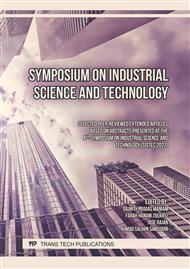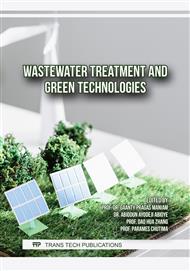[1]
Mosarof, M. H. et al. (2015) 'Implementation of palm biodiesel based on economic aspects, performance, emission, and wear characteristics', Energy Conversion and Management, 105, p.617–629.
DOI: 10.1016/j.enconman.2015.08.020
Google Scholar
[2]
Kushairi, A. et al. (2018) 'Oil palm economic performance in Malaysia and r&d progress in 2017', Journal of Oil Palm Research, 30(2), p.163–195.
DOI: 10.21894/jopr.2018.0030
Google Scholar
[3]
Nambiappan, B. et al. (2018) 'Malaysia: 100 years of resilient palm oil economic performance', Journal of Oil Palm Research, 30(1), p.13–25.
DOI: 10.21894/jopr.2018.0014
Google Scholar
[4]
Alternative Fuels Data Center. Biodiesel Blends. Energy Efficiency & Renewable Energy, U.S. Department of Energy on https://afdc.energy.gov/fuels/biodiesel_blends.html.
DOI: 10.1021/ef900878u
Google Scholar
[5]
S. M. Lopes & T. Cushing, The influence of biodiesel fuel quality on modern diesel vehicle performance, SAE Technical Papers (2012).
DOI: 10.4271/2012-01-0858
Google Scholar
[6]
R. Fraer et al., Operating experience and teardown analysis for engines operated on biodiesel blends (B20), SAE Technical Papers (2005).
DOI: 10.4271/2005-01-3641
Google Scholar
[7]
M. Lammert, R. Barnitt and R. L McCormick, Field evaluation of biodiesel (B20) use by transit buses, SAE Int. J. Commer. Veh. 2, 209–221 (2010).
DOI: 10.4271/2009-01-2899
Google Scholar
[8]
T.W. Tang, Y.Y. Ku and C. L. Chen, Impacts of biodiesel blends on fuel filters of high pressure common rail (HPCR) system, SAE Technical Papers (2016).
DOI: 10.4271/2016-01-1280
Google Scholar
[9]
T. F. Bunemann, P. Carress, H. Weiser and F. Bellgardt, Evaluation of engine oil performance with B5 and B20 biodiesel in a taxi fleet test, SAE Technical Papers vol. 9 (2012).
DOI: 10.4271/2012-01-1706
Google Scholar
[10]
X. He, A. Williams, E. Christensen, J. Burton and R. McCormick, Biodiesel impact on engine lubricant dilution during active regeneration of aftertreatment systems, SAE Int. J. Fuels Lubr. 4, 158–178 (2011).
DOI: 10.4271/2011-01-2396
Google Scholar
[11]
L. Jolly, K. Kitano, I. Sakata, W. Strojek and W. A. Bunting, Study of mixed-FAME and trace component effects on the filter blocking propensity of FAME and FAME blends, SAE Technical Papers (2010).
DOI: 10.4271/2010-01-2116
Google Scholar
[12]
M. Leustek, S. Charbonnel, J. Parsons and H. Abi-Akar, Field testing of high biodiesel blends on engine and aftertreatement durability, performance, and maintenance in an on-highway application, SAE Technical Papers vol. 2 (2013).
DOI: 10.4271/2013-01-0511
Google Scholar
[13]
R. Zdrodrowski et al., Effect of biodiesel (B20) on vehicle-aged engine oil properties, SAE Tech. Pap. 3, 579–597 (2010).
Google Scholar
[14]
Fuel & Lubricants Subcommittee. JAMA Position on the Use of Diesel Fuel Blended with FAME Concentrations in Excess of 5% on https://www.jama.or.jp/eco/wwfc/pdf/ FAME_JAMA_Supplementary_Position_Statement_December2016.pdf (2016).
Google Scholar
[15]
F. Motamen Salehi, A. Morina and A. Neville, The effect of soot and diesel contamination on wear and friction of engine oil pump, Tribol. Int. 115, 285–296 (2017).
DOI: 10.1016/j.triboint.2017.05.041
Google Scholar
[16]
M. A. Fazal, A. S. M. A. Haseeb and H. H. Masjuki, Degradation of automotive materials in palm biodiesel, Energy 40, 76–83 (2012).
DOI: 10.1016/j.energy.2012.02.026
Google Scholar
[17]
D. Chandran, H. K. Ng, H. L. N. Lau, S. Gan and Y. M. Choo, Deterioration of palm biodiesel fuel under common rail diesel engine operation. Energy 120, 854–863 (2017).
DOI: 10.1016/j.energy.2016.11.136
Google Scholar
[18]
M. H. Mosarof et al., Implementation of palm biodiesel based on economic aspects, performance, emission, and wear characteristics, Energy Convers. Manag. 105, 617–629 (2015).
DOI: 10.1016/j.enconman.2015.08.020
Google Scholar
[19]
S. M. Shanta, G. J. Molina and V. Soloiu, Tribological effects of mineral-oil lubricant contamination with biofuels: A pin-on-disk tribometry and wear study, Adv. Tribol. 2011, (2011).
DOI: 10.1155/2011/820795
Google Scholar
[20]
K. Vyavhare, S. Bagi, M. Patel and P. B. Aswath, Impact of diesel engine oil additives-soot interactions on physiochemical, oxidation, and wear characteristics of soot, Energy and Fuels 33, 4515–4530 (2019).
DOI: 10.1021/acs.energyfuels.8b03841
Google Scholar



